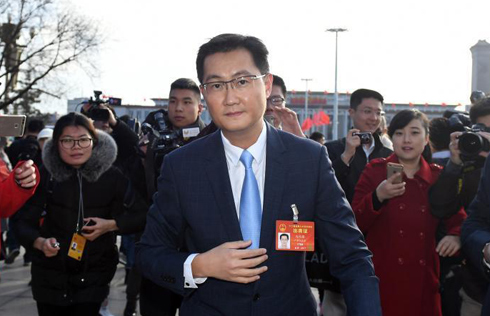China focuses on risk control as economy firms
BEIJING - China has moved to channel more energy into risk control in its financial sector after the slowing economy showed more signs of warming due to pro-growth measures.
The government work report delivered by Premier Li Keqiang on Sunday said that China will create a "firewall" to fend off financial risks, with sharp vigilance over non-performing assets, bond defaults, shadow banking and Internet finance.
It was the latest in an array of high-level official statements to curb risks and improve supervision in recent months. Also in the report, China trimmed its annual economic growth target to around 6.5 percent, a 25-year low.
UBS China economist Wang Tao believes the move signals the government's intent to balance the need to maintain solid growth and contain rising leverage and related risks.
China's investment-driven strategy allowed enviable GDP increases even during the turmoil of the global financial crisis, but rapid credit expansion has led to undesirable results.
Latest signs show that the Chinese economy is firming up, with both the official and private factory activity indexes posting steady growth. Exports and imports also staged strong rebounds.
Thanks to the stabilization, policymakers, which had been grappling with downward pressures, were finally able to shift their focus.
At the tone-setting Central Economic Work Conference in December, the central leadership pledged to make a priority of preventing financial risks, saying that curbing asset bubbles would be more important in 2017.
As part of the efforts in risk control, the People's Bank of China (PBOC), the central bank, has turned to a prudent and neutral monetary policy for this year, which means that slower money supply and higher lending costs can be expected.
"There might be a tightening bias in PBOC's financial stability operation in the first half of 2017," JP Morgan China economist Zhu Haibin said.
Affected by the policy shift, analysts predicted China's new yuan loans for February will drop substantially, retreating from a one-year high in January due to less capital flowing into the property sector.
Chen Yulu, deputy governor of the PBOC, vowed more efforts to prevent massive capital flows into bubble-prone areas and improve financial support for the real economy.
Rapidly developing financial technology in China has also posed challenges to supervisors, such as scandals in online P2P lending.
China should be vigilant about all kinds of financial risks as market development brings new products and new situations, said Yang Kaisheng, a special advisor to China's banking regulator, calling for effective measures to oversee financial transactions and products that have yet to be covered by government regulation.
A supervision coordination mechanism was proposed during a conference of the Central Leading Group on Finance and Economic Affairs at the end of February to better supervise new financial products.
In recent weeks, regulators in the banking, securities and insurance sectors took a series of actions to curb financial risks, penalizing insurers that participated in speculative buying of stocks and regulating deposit business of online lenders.
The country's focus on risk prevention has stoked concerns that authorities may be more cautious to carry out financial opening up and reforms.
Liu Shiyu, chairman of the China Securities Regulatory Commission, reassured investors on Tuesday, saying China will push for reforms steadily, rather than "taking long strides."
China has achieved considerable progress in opening its capital markets, loosening its grip on the yuan's exchange rate, allowing foreign institutions to enter its interbank markets and launching trade links between stock exchanges in the Chinese mainland and Hong Kong.
Economists said China's financial risks, although rising, are still under control as banks' bad loan ratios are at low levels and regulators have enough policy tools to maintain market stability.
Chinese banks saw their bad loan ratios drop to 1.74 percent at the end of 2016, down from 1.76 percent a quarter ago. The loan loss provisions of lenders, or funds set aside to cover potential loan losses, amounted to 2.67 trillion yuan ($390 billion).























